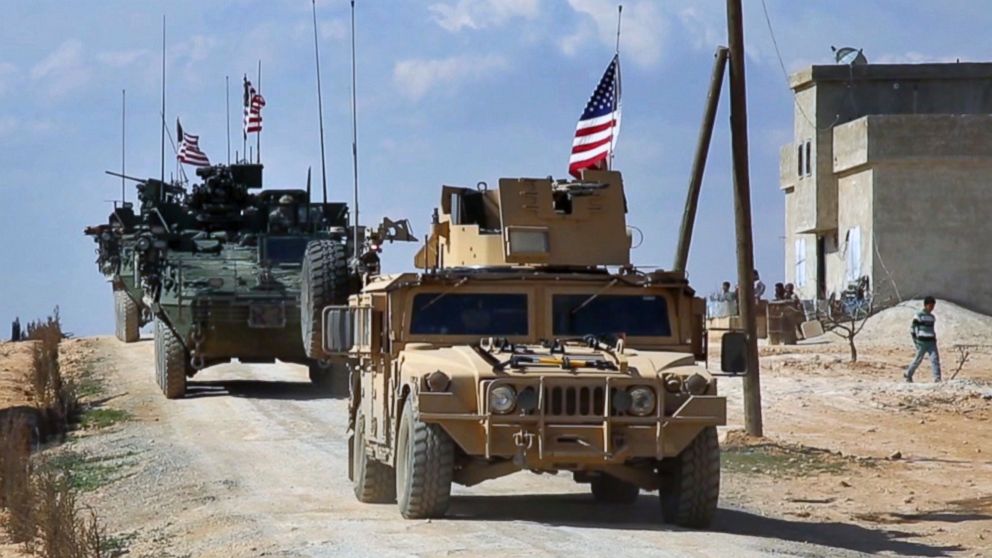The US has troops in Syria, and here's what they're doing
— -- On Tuesday, President Donald Trump said the U.S. is “not going into Syria” amid escalating tensions with the country after a chemical attack there killed more than 80 people.
But the reality is the U.S. has already had a military presence in the country since early 2016 to train and advise Kurdish and Arab rebel forces fighting ISIS in northern and eastern Syria. The number of these mostly special operations forces in Syria had grown to 500 by early this year.
Hundreds more Marines arrived in Syria in early March to provide artillery support to U.S.-backed Syrian rebels preparing to retake Raqqa, ISIS’s de facto capital in Syria.
Days earlier, a contingent of Army Rangers arrived in Manbij to essentially act as a visible presence to prevent the Turkish military and Kurdish forces from fighting each other in the city retaken from ISIS months ago, the officials said.
Additionally, the U.S. has conducted over 7,800 airstrikes in Syria as of March 28, according to the Department of Defense.
So, what are these additional Marines and Army Rangers doing in Syria? ABC News breaks down their role in the fight against ISIS.
Marine artillery unit near Raqqa
The artillery battery from the 11th Marine Expeditionary Unit arrived in Syria over the last couple of weeks to establish a fire base for their Howitzer artillery, according to a U.S. military official. The battery's M777 howitzers are capable of hitting targets up to 20 miles away.
The Marines will provide artillery support to the local forces, which have been working since December to isolate the city of Raqqa in advance of a full offensive on the city.
American military officials have often stated that the SDF will need additional combat power if they are to press into Raqqa, where ISIS has already established elaborate defenses. The Marine artillery would be able to provide additional combat support for SDF fighters in and around Raqqa.
The deployment to Syria is similar to one in early 2016, when 200 Marines established a fire base in northern Iraq to support Iraqi troops pushing northward toward Mosul. That Marine unit was subsequently replaced by an Army unit, the military official said. Depending on how the future fight for Raqqa progresses, it may not be necessary to replace the Marine artillery battery, the official added.
The military official said the deployment to Syria had been long-planned, but that the final decision to send them was only made recently by military commanders at U.S. Central Command. It did not require a presidential authorization since they were already in the Middle East and the movement of troops into Syria was not associated with the proposals presented to President Trump last week to accelerate the fight against ISIS.
Army Rangers in Manbij
A small force of Army Rangers was deployed to the northwest city of Manbij over the weekend to provide what a Pentagon spokesman called a "visible sign of deterrence.” Their presence is intended to prevent the possibility of Turkish troops and U.S.-backed Kurdish forces attacking each other.
These troops will “reassure and deter parties from attacking any other parties other than ISIS itself,” Pentagon spokesman Capt. Jeff Davis said in March.
Manbij was liberated from ISIS last August but remains an area rife with tension between Turkish troops and the Kurds.
While Turkey has not yet agreed to work with the Kurds (included in the SDF) to retake Raqqa, the U.S. is discussing what role they could play. Talking to reporters last month in Baghdad, Defense Secretary James Mattis said of having a strong Turkish element in the Raqqa fighting force, “We’re still sorting it out.”
Maintaining peace between the groups in Manbij will be crucial if they will work together in the battle for Raqqa.
Special operation troops
Former Defense Secretary Ash Carter announced in early December that 200 additional American special operations troops would join the 300 already serving in a train, advise and assist role inside Syria since early 2016.
Those 300 troops have been working with the SDF in fighting ISIS in northern and eastern Syria. A small number of these American forces have also been advising and assisting Turkish forces fighting ISIS in northwestern Syria.
Working in small teams, the special operations troops also provide explosive ordnance disposal assistance, and facilitate the communications and coordination needed for coalition airstrikes that have helped SDF fighters push ISIS out of long-held strongholds in northern and eastern Syria.
The American forces are supposed to do their work at the headquarters level, remaining behind the front lines. But given the fluid nature of the battlefield in Syria and the less structured command structure in the SDF, the American advisers could find themselves in a combat environment where they have to defend themselves if they come under attack.
The additional 200 added in December were meant to build on the momentum of the SDF and their offensive on Raqqa.
Over the past year, the SDF have pushed ISIS out of the cities of Kobani, Jarabulus, Manbij and al-Shaddadi.




